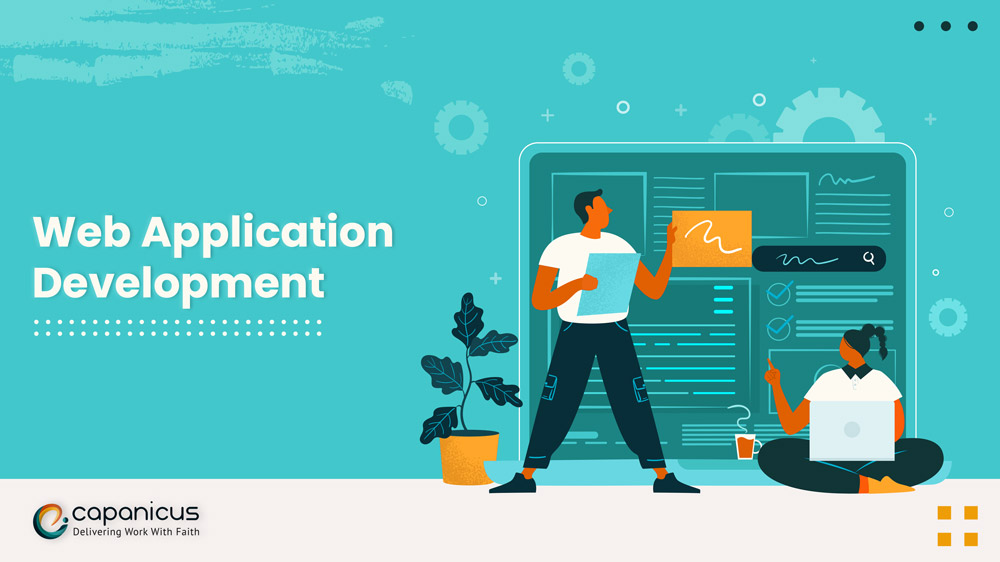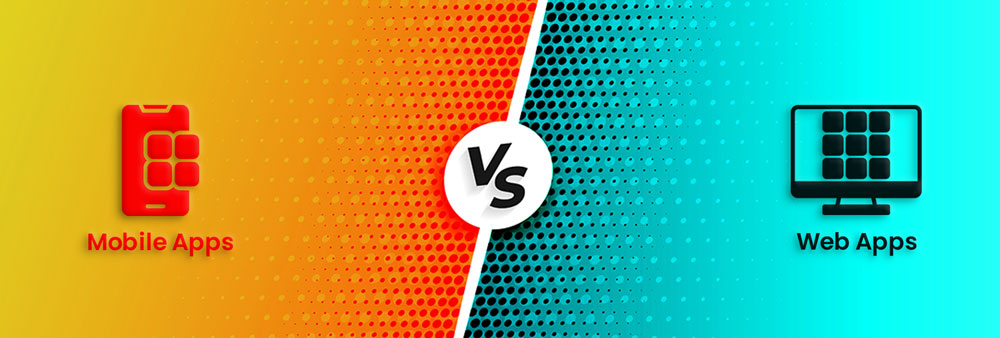What is Web Application Development?

Web application development refers to the creation of applications that are accessed over the internet through a web browser. These applications are typically dynamic and interactive, allowing users to perform various tasks and access data or information online. The development process involves designing and coding the application, implementing features and functionalities, and integrating it with a back-end database or server. Web application development requires proficiency in programming languages such as HTML, CSS, and JavaScript, as well as frameworks and libraries that enhance the development process. The end goal is to create a user-friendly and efficient web application that can be easily accessed and used by individuals or businesses for various purposes.
How Does a Web Application Work?
A web application is a software application that runs on a web server and can be accessed through a web browser. It consists of two main components: the front end and the back end. The front end, also known as the client side, is part of the web application that interacts directly with the user. It is responsible for presenting the user interface and handling user interactions. This is typically done using HTML, CSS, and JavaScript. HTML defines the structure and content of the web page, CSS is used to style the elements on the page, and JavaScript provides interactivity and functionality.
The back end, also known as the server side, is the part of the web application that handles the business logic and data processing. It is responsible for receiving requests from the front end and processing them. This is typically done using a server-side programming language like PHP, Ruby, Python, or Java. The back end interacts with the database and other external systems to retrieve and store data. When a user interacts with a web application, their browser sends a request to the web server hosting the application. The web server then processes the request and sends back the appropriate response. This response is typically an HTML document that the browser renders and displays to the user. The browser may also make additional requests for additional resources like CSS or JavaScript files.
Overall, it works by combining the front-end and back-end components to deliver a dynamic and interactive user experience through a web browser. The front end handles the presentation and user interactions, while the back end handles the processing and storage of data.
Web Development Trends for 2023

Predicting web development trends for a specific year like 2023 is challenging as technology evolves rapidly. However, based on current industry trends, here are some possibilities for web development in 2023:
Progressive Web Apps (PWAs): PWAs continue to gain popularity due to their ability to provide a native app-like experience on the web. They offer faster loading times, offline capabilities, and push notifications.
Voice User Interface (VUI): With the rise of smart speakers and voice assistants, more websites may incorporate VUI technology to provide voice-based interactions and commands. This trend will likely continue in 2023 as natural language processing and voice recognition technology advance.
Artificial Intelligence (AI): AI-powered web development tools and frameworks are becoming more prevalent. AI can help automate repetitive tasks, optimize user experiences, and personalize content based on user behavior. Expect AI to further shape web development processes in 2023.
Augmented Reality (AR) and Virtual Reality (VR): AR and VR technologies are gaining traction, enabling immersive user experiences. In 2023, more websites may integrate AR and VR elements to engage users, showcase products, and deliver interactive content.
Accelerated Mobile Pages (AMP): AMP is an open-source initiative aiming to improve mobile web performance and user experience. It prioritizes fast-loading and mobile-optimized pages. As mobile usage continues to rise, AMP adoption is expected to continue in 2023.
Chatbots and AI-powered assistants: Chatbots are becoming increasingly sophisticated, thanks to advancements in AI and machine learning. In 2023, more websites may leverage chatbots and AI-powered virtual assistants to provide instant support, answer queries, and interact with users.
Responsive design and mobile-first approach: As mobile devices dominate internet usage, websites must prioritize responsiveness and mobile optimization. Web designers and developers will likely continue to focus on creating mobile-first experiences and ensuring seamless responsiveness across all devices.
Blockchain integration: Although primarily associated with cryptocurrencies, blockchain technology has potential beyond that. In 2023, websites may explore blockchain integration to enhance security, transparency, and peer-to-peer interactions.
Dark mode and accessibility: Dark mode has gained popularity due to its aesthetic appeal and battery-saving possibilities on OLED screens. In 2023, more websites may provide dark mode options. Additionally, improving accessibility will remain crucial, focusing on inclusive design to ensure websites are usable for people with disabilities.
Remember that these predictions are speculative and technology can evolve quickly, so new trends and advancements may emerge before or during 2023. It’s essential for web developers to continually stay updated and adapt to grow with the evolving landscape.
The Future of Web Application Development
The future of web application development looks promising with the rapid advancements in technology. As more and more businesses and individuals rely on web application solutions for various purposes, developers will have to keep up with the increasing demands and expectations.
One key aspect of the future of web application development services is the integration of Artificial Intelligence (AI) and Machine Learning (ML) technologies. AI and ML can greatly enhance the user experience by providing personalized and intelligent recommendations, predictive analytics, and automation of repetitive tasks. Developers will need to have a solid understanding of these technologies to create smart and efficient web applications.
Another trend that will shape the future of web application development is the shift towards Progressive Web Apps (PWAs). PWAs combine the best features of both web and mobile applications, providing users with a seamless experience across different devices and platforms. With PWAs, developers can create web applications that can be installed on a user’s device and accessed even without an internet connection.
Furthermore, the rise of Internet of Things (IoT) devices will also impact web application development. As more devices become interconnected and capable of accessing the internet, developers will need to create web applications that can integrate and communicate with these devices. This will require a new set of skills and knowledge in areas such as IoT protocols, security, and data management.
The future of web application development will also be shaped by the ongoing advancements in web development frameworks and tools. Frameworks such as React, Angular, and Vue.js are continuously evolving and becoming more efficient, making it easier for developers to build complex and scalable web applications. Additionally, the rise of low-code and no-code platforms will democratize web development, allowing individuals with minimal coding knowledge to create web applications.
The future of web application development is exciting and full of possibilities. Developers will need to adapt to the ever-changing landscape of technology, incorporating AI, ML, IoT, and other emerging trends into their skills. By staying informed and continuously learning, developers can create innovative and user-friendly web applications that meet the demands of the future.
Most Common Comparisons with Web Application Development

1. Web Applications vs Mobile Applications
Web Applications |
Mobile Applications |
| Applications for mobile devices are designed to run on certain operating systems, such as Windows, iOS, or Android. | Web apps are programs that run in web browsers; they often use JavaScript or HTML5. |
| You can get mobile applications from the Apple App Store and Google Play Store. | Browser-based web apps can be accessed by web browsers like Mozilla Firefox, Safari, or Google Chrome. |
2. Web Applications vs Websites

Web Applications |
Websites |
| A website is a collection of linked material and web pages that are hosted on at least one web server and are recognized by a common domain name. | A web application is a program that runs on a distant server and is accessed via a browser on the Internet. |
| A website serves as a communication tool. | A web application is used for tasks to accomplish certain objectives. |
| A website allows data visualization (reading and comprehending). | A web application allows data manipulation. |
| A website requires less computing power and fewer resources. | A web application requires greater processing power and resources. |
Types of Web Applications
Static web application The user experience is sustained and consistent when using static web applications. It is typically created for businesses or organizations that have a long-term perspective.
Dynamic web applications Online surveys and contact forms are examples of dynamic web applications that are used for short-term data collection and processing.
E-commerce web application Web applications for e-commerce are used to sell goods and services online. Typically, this application’s payment processing is integrated within the system. These days, new technology advancements allow one to construct a completely effective e-commerce online site without having to buy or set up a dedicated server.
Portal web application A web destination that combines all the information a business or organization offers—such as contact details, available goods and services, and therefore forth—is created using a portal web application. A portal can be thought of as a multi-story digital towering structure. Every floor serves a distinct purpose.
Content management system A content management system is used to manage postings, articles, surveys, and other content on an Internet website. The contents are typically maintained by an administrator. Editors can update current ones or add new ones using the system.
Single-page application Applications that function as a whole yet don’t require downloading extra files are created using single-page applications. It downloads dynamically, when needed, and doesn’t rely on any back-end technologies.
Server-side web applications Single-page apps are those that work as a whole without requiring the download of additional files. It doesn’t rely on any back-end technologies and downloads dynamically as needed.
Client-side web application Building online apps that operate exclusively on a user’s computer, or the client side, is known as client-side web application development.
These are the various kinds of web applications; as a company, you can select the one that most closely matches your requirements. Now that you’ve seen the various kinds of web applications, are you able to think of any that load quickly? These kinds of websites are known as progressive websites. Let’s investigate the same to gain a better comprehension!
What is a Progressive Web Application?
A Progressive Web Application (PWA) is a type of web application that combines the best features of both a website and a native mobile application. It functions as a regular website but offers an enhanced user experience similar to that of a mobile app. PWAs utilize modern web technologies such as HTML, CSS, and JavaScript to provide features like offline access, push notifications, and device hardware integration. They can be accessed directly through a web browser, eliminating the need for users to download and install them from app stores. PWAs are designed to be responsive, reliable, and fast-loading, offering a seamless and engaging experience across multiple devices. With its versatility and convenience, PWA technology is gaining popularity with businesses and developers looking to provide a native-like mobile experience on the web.
What is the Cost of Web App Development?
Cost is a subjective factor that is entirely dependent on the final user. Each business has a unique niche, meaning it has unique needs. There is no one-size-fits-all set cost because of this. The size of a company’s operations and the complexity of the web application they wish to have constructed will determine how much it will cost. It will also depend on the kind of application they require, i.e., whether they require a basic contact form, an online survey system, or an e-commerce website. Now that you are aware of the variables that affect web app development costs, let’s discuss the entire tech stack needed for this process.
- Front-end or client-side technologies (MEAN, MERN, MEVN)
- Back-end or server-side technologies (PERN)
- Database (LEAN)
These are the top web stack technologies; as a company, you need to choose the right stack for the job. Again, there are a few considerations you should make before selecting one.

Conclusion
Web apps are highly preferred by businesses because of their many benefits. It continues to offer substantial commercial support by expanding its reach. Additionally, web apps are increasingly popular due to their versatility, cloud server storage, and ease of usage on any platform! Our professionals are here to provide you with individualized web application development services so that you may be guided in the finest directions.
At Capanicus, we develop apps that are customized to satisfy every requirement of your business. With the best web app services, our experts can aid you if the off-the-shelf apps you’re using aren’t able to grow with your business or stay up.


